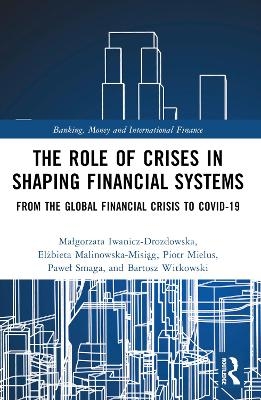
The Role of Crises in Shaping Financial Systems
Routledge (Verlag)
978-1-032-12642-5 (ISBN)
The Role of Crises in Shaping Financial Systems: From the Global Financial Crisis to COVID-19 underscores the role of crises as turning points for the financial sector and its interactions with the real economy. It sheds new light on the financial industry through the lens of three recent crises – the global financial crisis, the sovereign debt crisis, and the COVID-19 pandemic. The book provides in-depth insight into the financial systems in European Economic Area countries, accentuating the role of crises in shaping the condition and development of the financial arena. The authors pay special attention to the differences between “old” and “new” Europe, i.e. countries that joined the EU in 2004 or later. It explores the implications of recent turbulences for financial institutions, financial markets, and public finance, and their relationship with the economy. The book examines low or negative interest rates, non-standard monetary policy, fiscal stimulus, dense safety nets, regulatory inflation, weak profitability of the financial sector, and the sovereign-bank nexus. Post-crisis developments are assessed, comprehensively and empirically, from both macro- and microeconomic perspectives to help readers understand the nature of policy measures and their socio-economic implications.
The authors outline their predictions for the future of financial systems, focusing on the structural changes and legacy of the COVID-19 crisis and global financial interlinkages.
The book adopts both theoretical and practical approaches to explore the key issues and, as such, will appeal to academics and students of financial economics and international finance, as well as policymakers and financial regulators.
Małgorzata Iwanicz-Drozdowska is a Full Professor of Economics and Finance and head of the Financial System Department at SGH Warsaw School of Economics, Poland. Elżbieta Malinowska-Misiąg is an Assistant Professor at the Financial System Department, SGH Warsaw School of Economics, Poland. Piotr Mielus is an Associate Professor of Economics and Finance at SGH Warsaw School of Economics, Poland. Paweł Smaga is an Associate Professor at the Financial System Department, SGH Warsaw School of Economics, Poland. Bartosz Witkowski is a Full Professor of Economics and Head of the Institute of Econometrics at SGH Warsaw School of Economics, Poland.
1. Chapter 1. Introduction, 2. Chapter 2. Safety net reactions to crises, 2.1. Monetary response, 2.2. Prudential response, 2.2.1. Regulatory measures, 2.2.2. Lessons learned? Impact of regulatory and institutional overhaul, 2.2.3. First experiences with macroprudential policy in the EU, 2.3. In the eye of the storm - crises and banking sector financial standing, 2.3.1. Pre- and post-crisis trends in the European banking sector condition, 2.3.2. Determinants of bank soundness during crises, 3. Chapter 3. Fiscal policy reaction to crises, 3.1. Policy response – towards strengthening European integration, 3.1.1. EU emergency and recovery initiatives, 3.1.2. Tailoring the state aid framework, 3.1.3. Strengthening the fiscal framework, 3.1.4. Financial assistance facilities, 3.2. Support measures for the financial system – case studies, 3.2.1. Ireland, 3.2.2. Greece, 3.2.3. Cyprus, 3.3. Support measures for the real economy – case studies, 3.3.1. Germany, 3.3.2. Poland, 3.4. Balancing fiscal and financial stability, 4. Chapter 4. Financial markets in crises, 4.1. Origin of asset pricing – who drives the market in a crisis?, 4.2. Financial markets in crisis – a victim or a culprit?, 4.3. Emerging markets asymmetry – how contagion works?, 4.4. Case studies for foreign exchange, interest rate, liquidity and equities, 5. Chapter 5. The interplay between the financial sphere and the real sphere, 5.1. Finance and growth nexus – state of play, 5.2. Tail wagging the dog?, 5.3. Financial and real spheres in Western and Eastern Europe , 5.3.1. Financial and real spheres in Europe, 5.3.2 Data and methodology, 5.3.3 Results and discussion. Tail (finance) wagging the dog? 6. Chapter 6. Challenges ahead
| Erscheinungsdatum | 05.10.2022 |
|---|---|
| Reihe/Serie | Banking, Money and International Finance |
| Zusatzinfo | 30 Tables, black and white; 24 Line drawings, black and white; 24 Illustrations, black and white |
| Verlagsort | London |
| Sprache | englisch |
| Maße | 156 x 234 mm |
| Gewicht | 453 g |
| Themenwelt | Sozialwissenschaften ► Soziologie ► Spezielle Soziologien |
| Wirtschaft ► Volkswirtschaftslehre ► Makroökonomie | |
| Wirtschaft ► Volkswirtschaftslehre ► Mikroökonomie | |
| Wirtschaft ► Volkswirtschaftslehre ► Wirtschaftspolitik | |
| ISBN-10 | 1-032-12642-6 / 1032126426 |
| ISBN-13 | 978-1-032-12642-5 / 9781032126425 |
| Zustand | Neuware |
| Haben Sie eine Frage zum Produkt? |
aus dem Bereich


